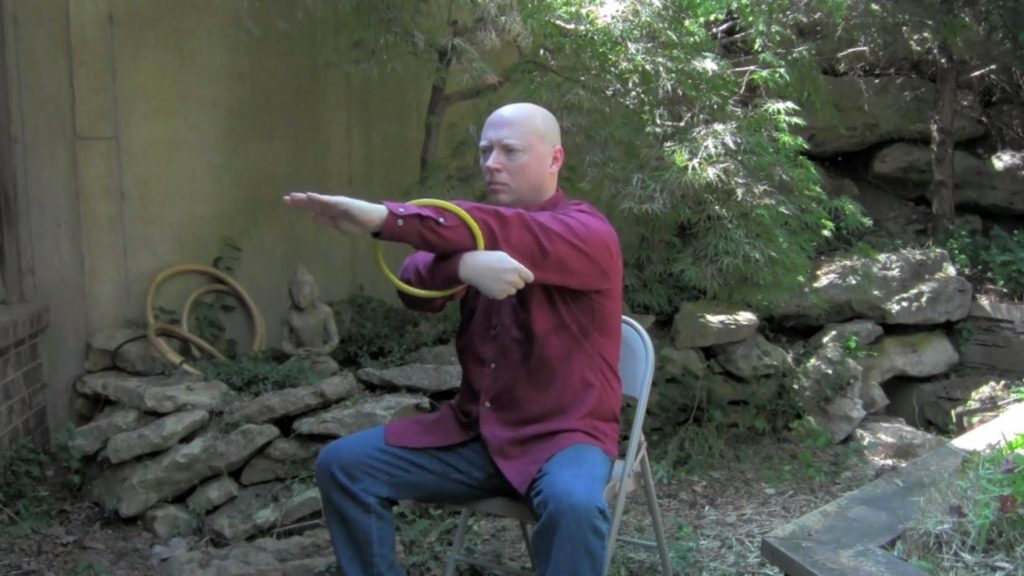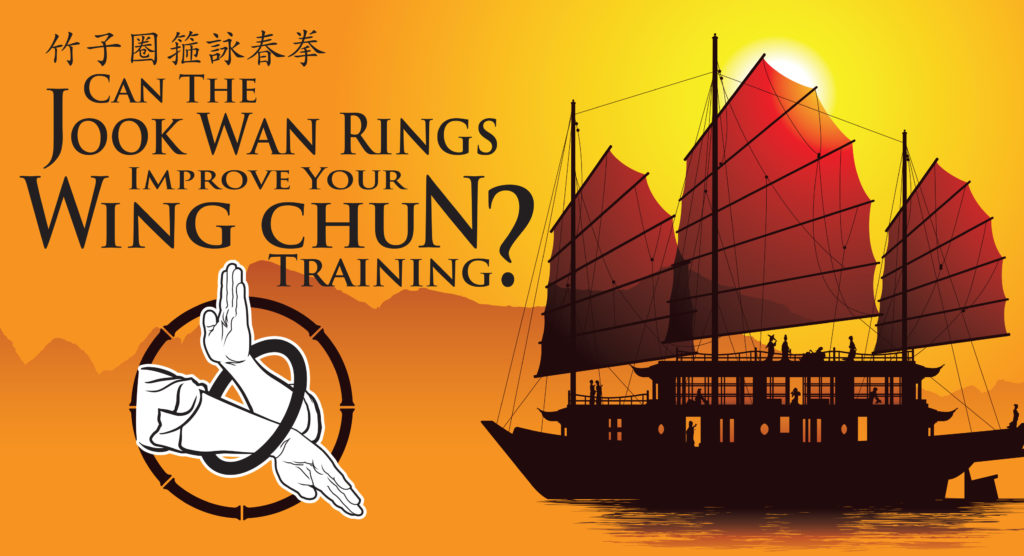For this interview we sat down and asked Sifu Rea a few questions about the Wing Chun rings.
Can you tell us how you discovered the Wing Chun rings? Is it something your Sifu (Sifu Kwai) would frequently use?
In the late 1980s I was looking for a Wing Chun teacher and was introduced to Sifu Kwai through my Silat teacher. I was fortunate to meet him in several respects and was very impressed with his abilities.
At that time his Wing Chun especially interested me as my previous Wing Chun teacher was filling in the gaps in his Wing Chun knowledge with Hung Gar, which made genuine study of the system difficult. The first time I saw the Jook Wan ring was when having lessons at Sifu’s house. I noticed he had these bamboo rings hanging in various parts of the house, but at first I thought they were decorative.
It wasn’t until I went to use the bathroom and saw they were hanging next to the toilet that I was motivated to ask Sifu Kwai what these bamboo ring were for. When I asked why they were in the bathroom he smiled and said, “If one has time to sit, one has time to train.” He collected a pair of rings and gave me my first lesson in the details of the Jook Wan’s use and exercises.

What are the advantages to training with them?
Well, there are two kinds of training benefits of the Jook Wan.
The first is, naturally, from the perspective of Wing Chun and the stages of training meant to cultivate unified body structure, with nested levels of rotational power. Although the Jook Wan training may be practiced at any stage of the Wing Chun system, it represents a tactical tier of training in line with the Wooden Dummy, Long Pole, and Double Knives.
This aspect is first presented to the practitioner within the training of the Biu Jee form and is the “Gao gup ging sao” (Emergency Contingency Hands). This is because all martial arts, regardless of cultural roots, know that the most important and critical martial movements they employ will fail, and it is never a matter of “If,” but a matter of “When.” This element of training is introduced to students in a variety of ways, sometimes unspoken, but is meant to acknowledge three very important details of combat that no practitioner can anticipate, no matter their skill level.
The First Problem – A Larger Attacker:
Far too often within both the context of the classroom and our personal approach to training, a practitioner will avoid larger training partners. This is in part because the effectiveness or ineffectiveness of our skills becomes glaringly apparent when confronting a larger opponent in combat.
The Second Problem – Multiple Attackers:
My Silat teacher was always fond of reminding me that wolves hunt in packs and that I should always view a potential self-defense situation with that in mind. I have taken this detail of training so to heart that I was able to subdue and retain for the police a group of four teenagers who broke into a business next to my school, and did so without raising a hand to harm them. But that story is for another interview.
The Third Problem – Armed Attackers:
It is practically a certainty that whoever attacks you will be armed or within reach of a weapon.
The second training benefit is for non-Wing Chun practitioners. Martial artists from diverse schools will benefit from the consolidated combat frame, vorticular power, and unified body structure that comes from Jook Wan training.
Any disadvantages? Some Wing Chun practitioners claim they cause you to develop bad habits. For example, causing you to train your Chi Sau pressure outward as opposed to forward into your opponent.
At first glance, a Wing Chun practitioner (or other martial artist) could draw the conclusion that Jook Wan training is counterproductive to the currently accepted Chi Sao training paradigm. I would however disagree, Jook wan training cultivates a forward drilling power that can expand and contract, adaptable to the opponents pressure.
It is true that there is a measure of outward pressure needed to maintain contact with the Jook Wan ring. This level of pressure must be small so as not to damage the ring or warp the movements expressed by it. As one practices the Jook Wan ring, it quickly becomes apparent, as it does when training the wooden dummy, that no movement or technique will be effective without the unified coordination of the whole body applied behind the movement of the bridge arms.
Please keep in mind that what is currently practiced as Chi Sao is often a VERY social exercise of highly reciprocal patterns of predictable exchange. These social Chi Sao patterns intrinsically create rather than negate the opportunity for the opponent to counter our movement.
The late GM Yip man stated, “Without Chi Sao there is no Wing Chun,” but a Wing Chun practitioner must never lose sight of the fact that Chi Sao is a living combat simulator much like the “danger room” of the X-men or the holodeck in Star Trek. Chi Sao is not actual combat and the practitioner must never assume that techniques, even if they crystallize as trained, will apply as trained. Let me also emphatically state that the higher levels of martial skill that are at the core of effective self-defense and combat rest upon the practitioner’s ability to adapt and apply variations of simple movements.
Every single Chi Sao progression and contingency counter must be subjected to a wide range of combat circumstances. Moreover, a Chi Sao progression, assuming it is a training progression taught by a knowledgeable instructor to a student who is capable of learning and reproducing it, must negate the opportunity of counter by the opponent. It is, unfortunately, too often the case that Chi Sao becomes a perpetual exchange of single attacks volleyed back and forth like a tennis match. In order to be effective, Chi Sao must be played like billiards, eliminating the opponent’s opportunity to set up or execute attacks.
I’ve never trained the Lee Bing Choi lineage, but it appears the style puts an emphasis on going around your opponent, as opposed to typical Ip Man linage that emphasizes constantly going forward into them. Is that correct?
That is correct. — It is the assumption of Jook Wan training that regardless of how refined and precise a Wing Chun practitioner’s structure is, it will fail. As with any military campaign or tactic, backup contingencies must exist nested in the very elements that have the possibility to fail.
It is a fact that a Wing Chun practitioner can be overwhelmed by the mass and momentum of a larger opponent or by the combined force of several. Therefore, adaptable counterattacks must dove-tail with the opponent’s aggressive pressure and deploy so as to ride the wave of pressure and borrow from it.
Again this is without ever training Lee Bing Choi or the rings. I’ve often wondered if training with the rings is lineage specific or is something all practitioners can use. It would be wonderful to hear your perspective on this issue.
Jook Wan training is neither lineage specific, nor a training stage meant to stand alone. Sound martial knowledge and training methods are never the proprietary domain of any one system or individual.
Any final thoughts on training with the rings or Lee Bing Choi linage?
Jook Wan training is another simple and compact way to cultivate Wing Chun skills, that is especially applicable in todays busy world.
What book or DVD, if any, had the biggest impact on your training?
The Tiger of Liberty video series by Sifu Patrick Hodges of Hawaii. Sifu Hodges produced a fantastic series of archival and instructional footage. Each volume was generously full of information presenting well known arts, as well as rare systems of Fut Gar, Hakka boxing, Tao style, Mantis, & Monkey boxing.
Do you have any new books or videos coming out?
Currently, I’m doing research for two books. The first, I hope, will be out in about three months. The first book covers the hidden methods of encoding and transmitting Asian martial knowledge in temples, statues, and Buddhist stupas. This allows later generations to recover lost knowledge over the ages and is designed to safeguard against knowledge being completely lost.
The second book and accompanying videos cover Hakka Kung Fu and its influence on Fut Gar, Boat Boxing, and other martial arts throughout Southern China and Malaysia.
Thank you for your Questions, Best regards, and Success in your Practice.
Want to learn more from Sifu Rea? Check out his Wing Chun Rings course in Wing Chun University.

